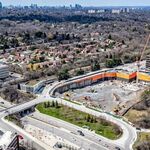- it's worth noting the locations. I was struck by the number that are on major streets.
- Paul
I'm surprised that you're surprised by that.
I would argue that's a function of :
1) Volume, there are simply many more cars on major streets than minor ones, indeed, there are also likely to be more pedestrians too, even on comparatively pedestrian unfriendly suburban thoroughfares.
2) Vehicle speed, likely faster on wider roads
3) You'll note many of the problems occur at intersections, with the single most common being associated with left-hand turns I believe. This occurs because many cars advance into the intersection with the anticipation of making a left,
then find they have increasingly little, or no green time left and have to move before they end up in the way of perpendicular traffic. The sense of pressure to make a move, sometimes with motorists honking in behind, while pedestrians may still be in the intersection, and having to track much more data as a driver (more lanes of traffic) and do so over a larger area that may not be entirely within your field of vision. Even right-hand turns can be an issue as you potentially have traffic coming from the left, someone impatient behind you, pedestrians in at least one crosswalk etc.
4) Wide crossing distances for pedestrians lead to greater likihood of being missed by a motorist, of missing conflicting traffic yourself, of dropping an item, tripping etc. which may make you invisible for a moment if below the hood-view of a car.
5) Lots more trucks, which tend to have greater difficulty seeing pedestrians or cyclists up close.







